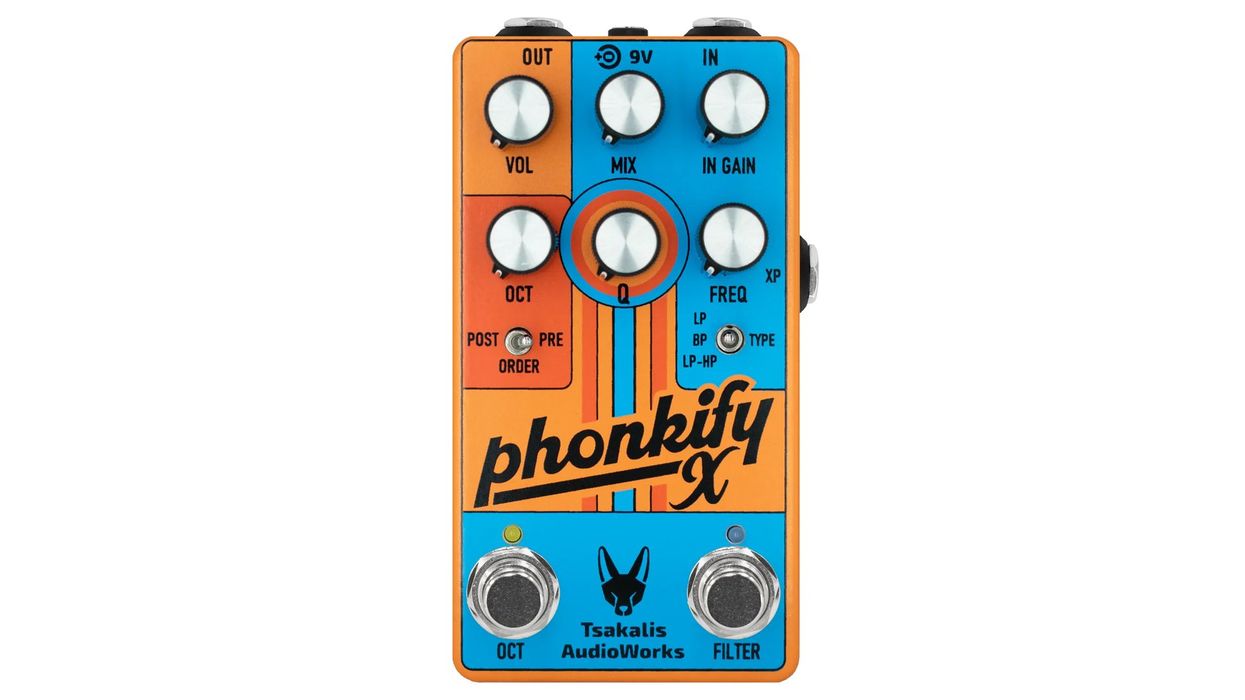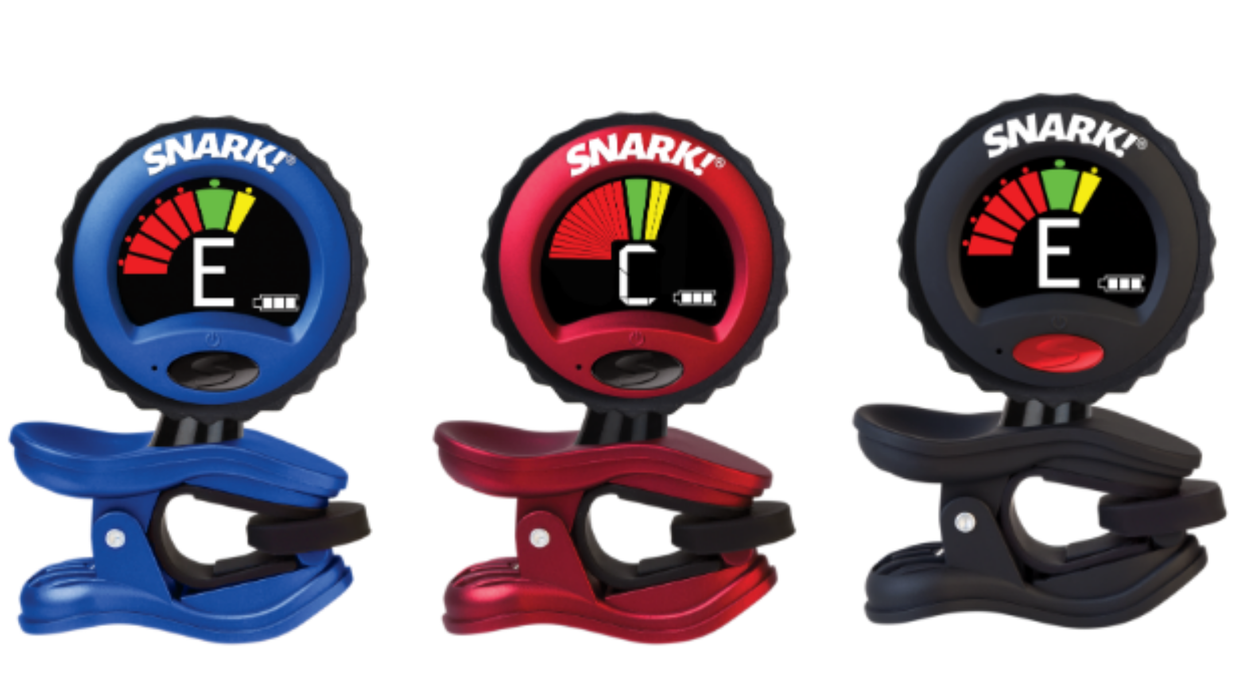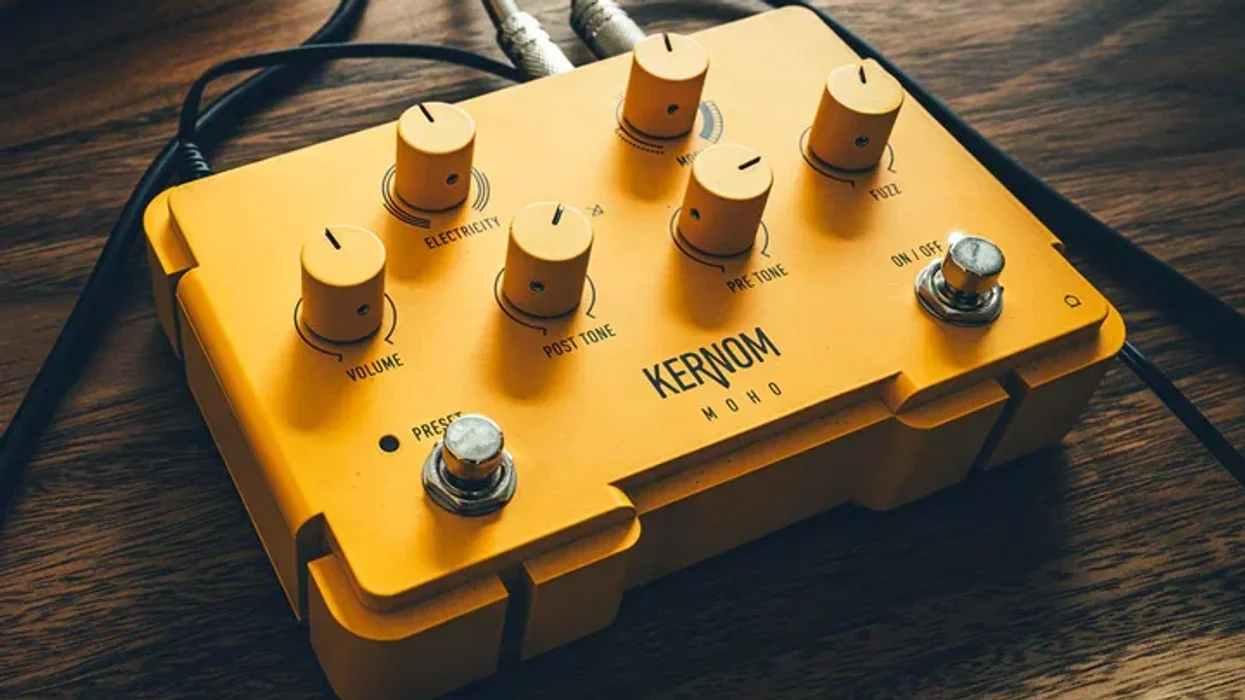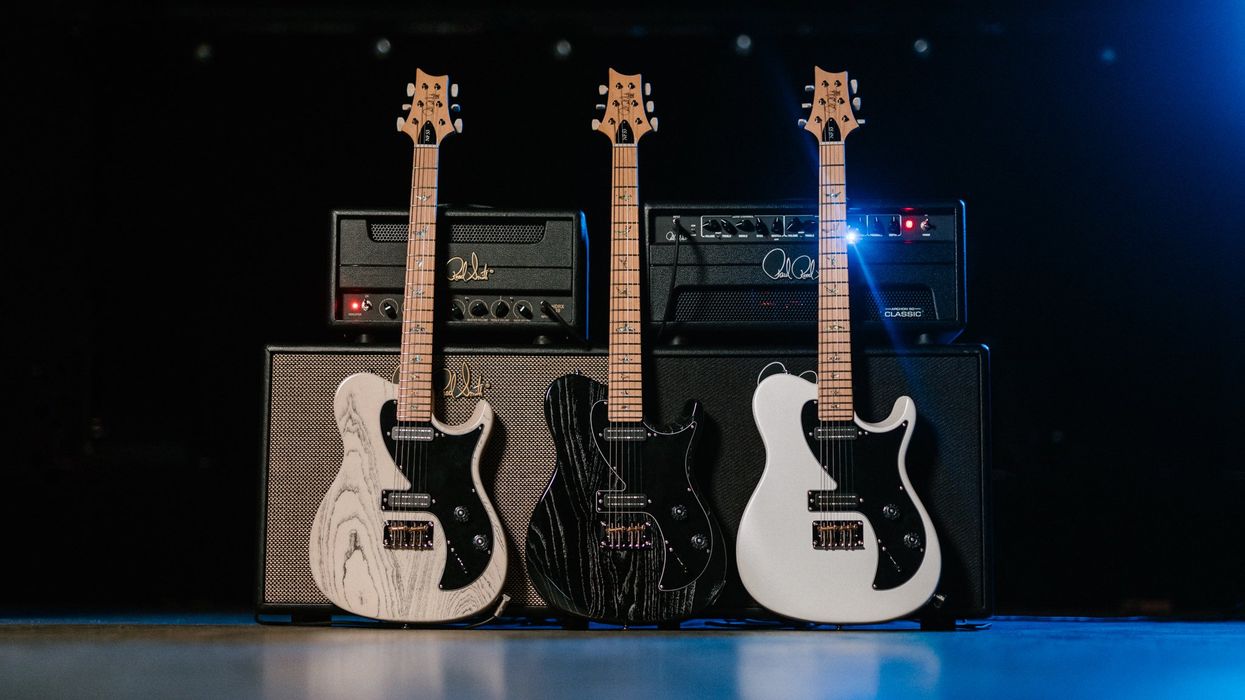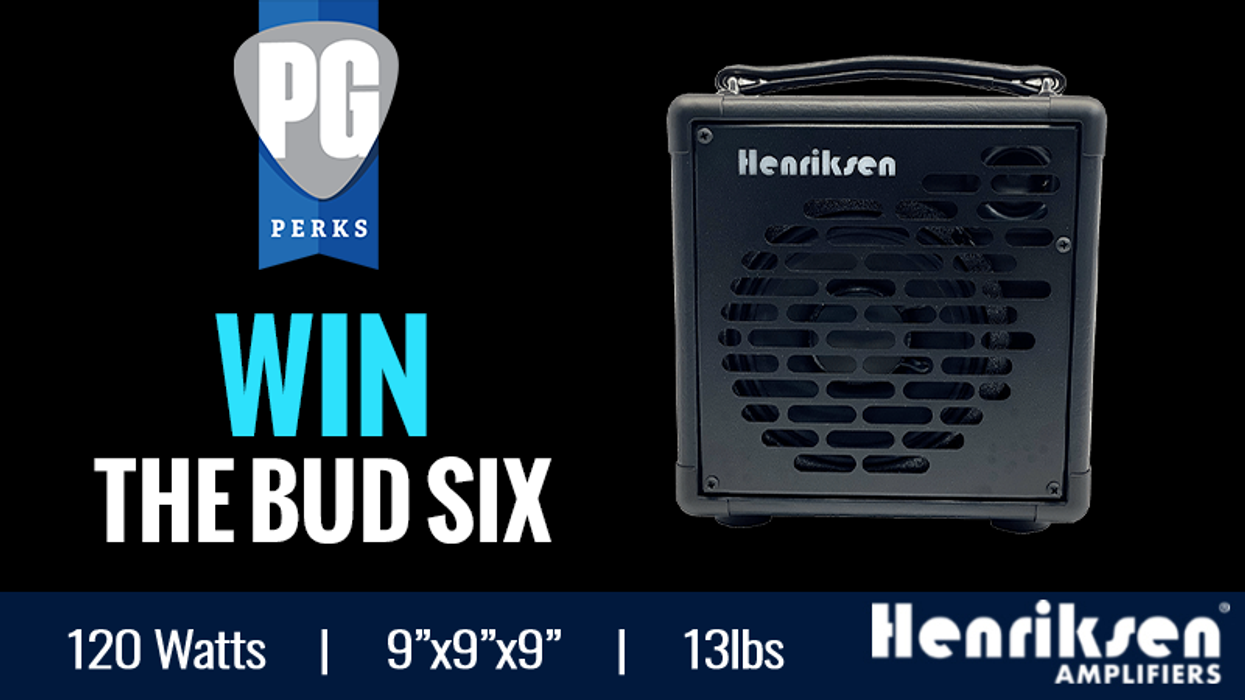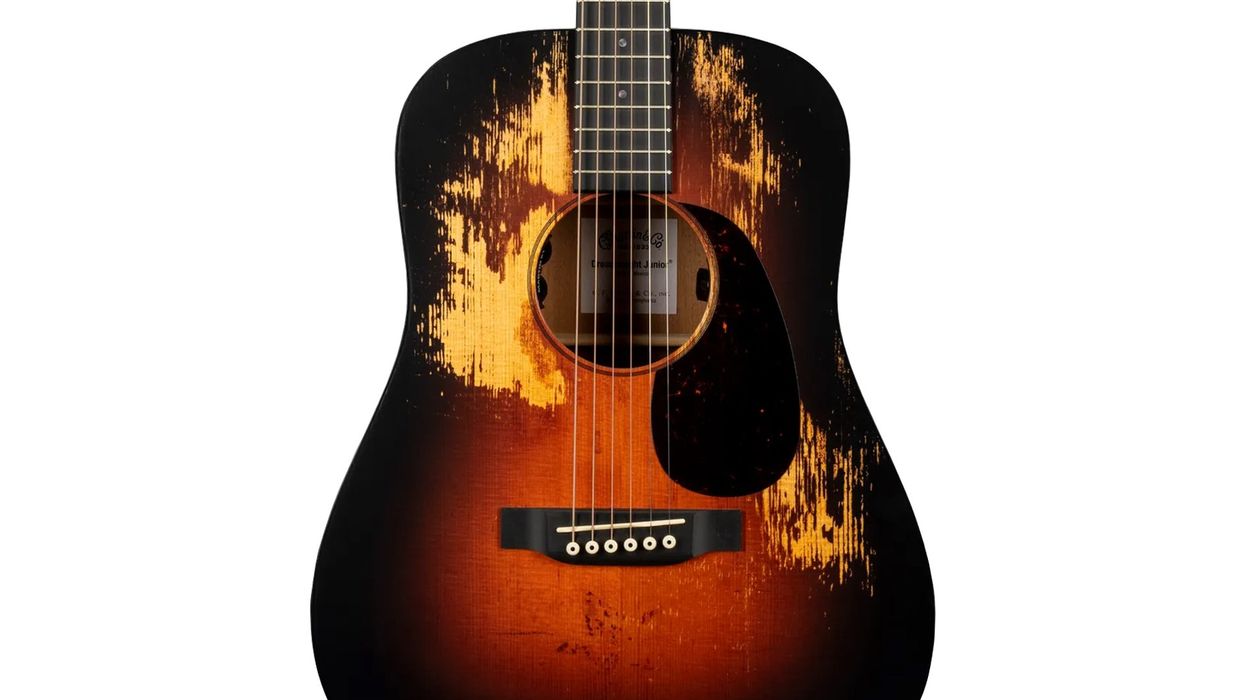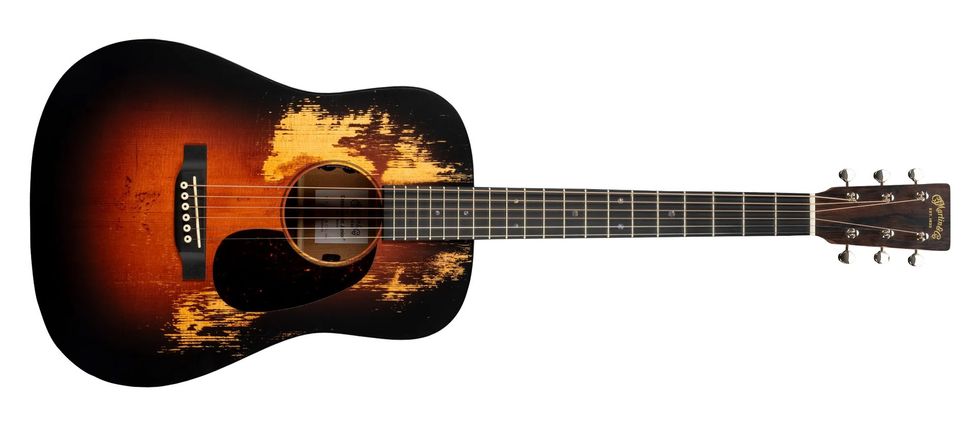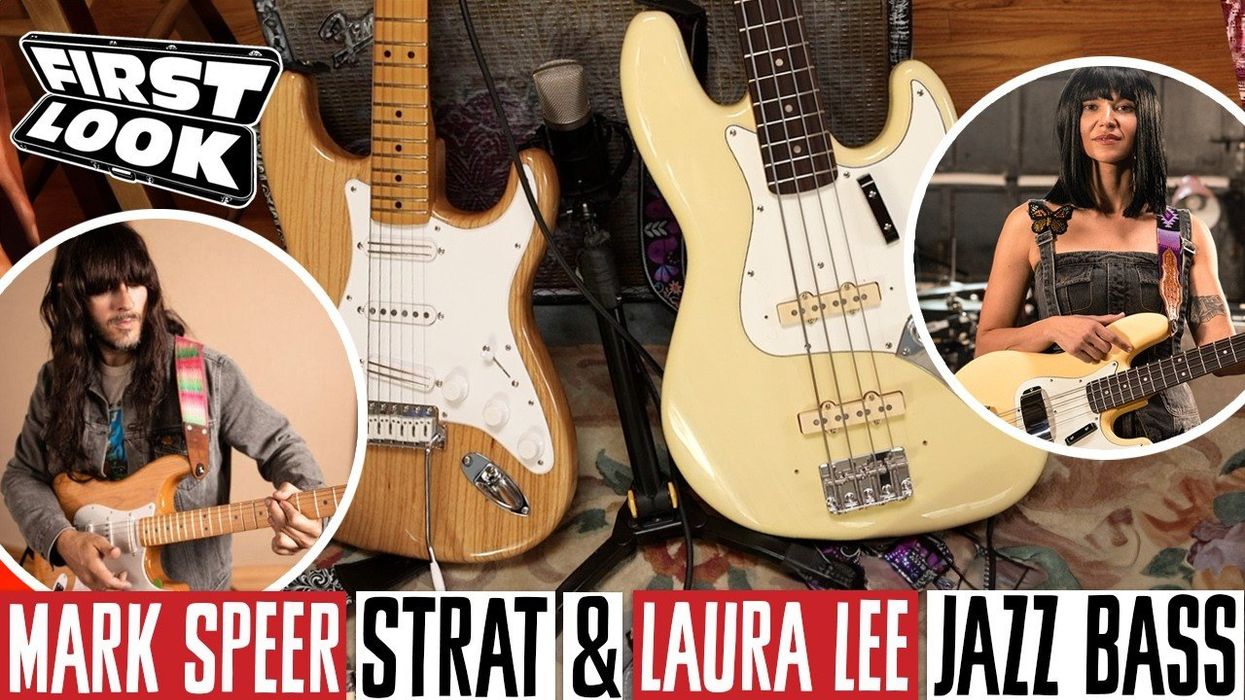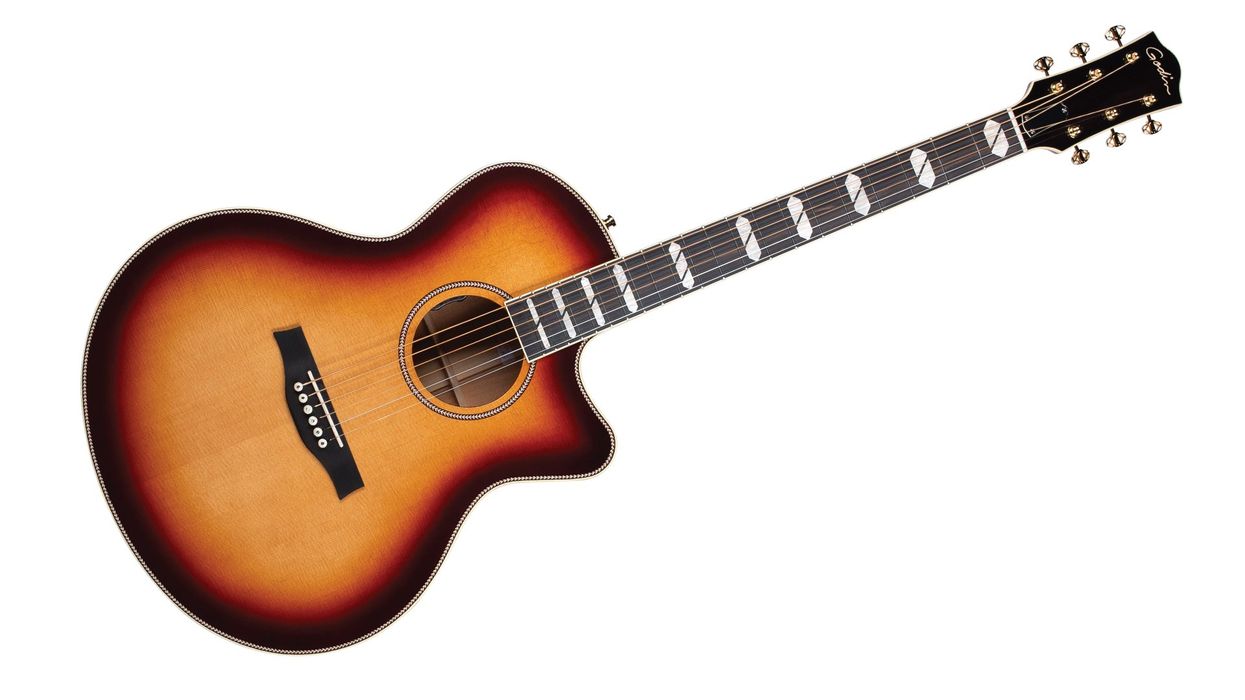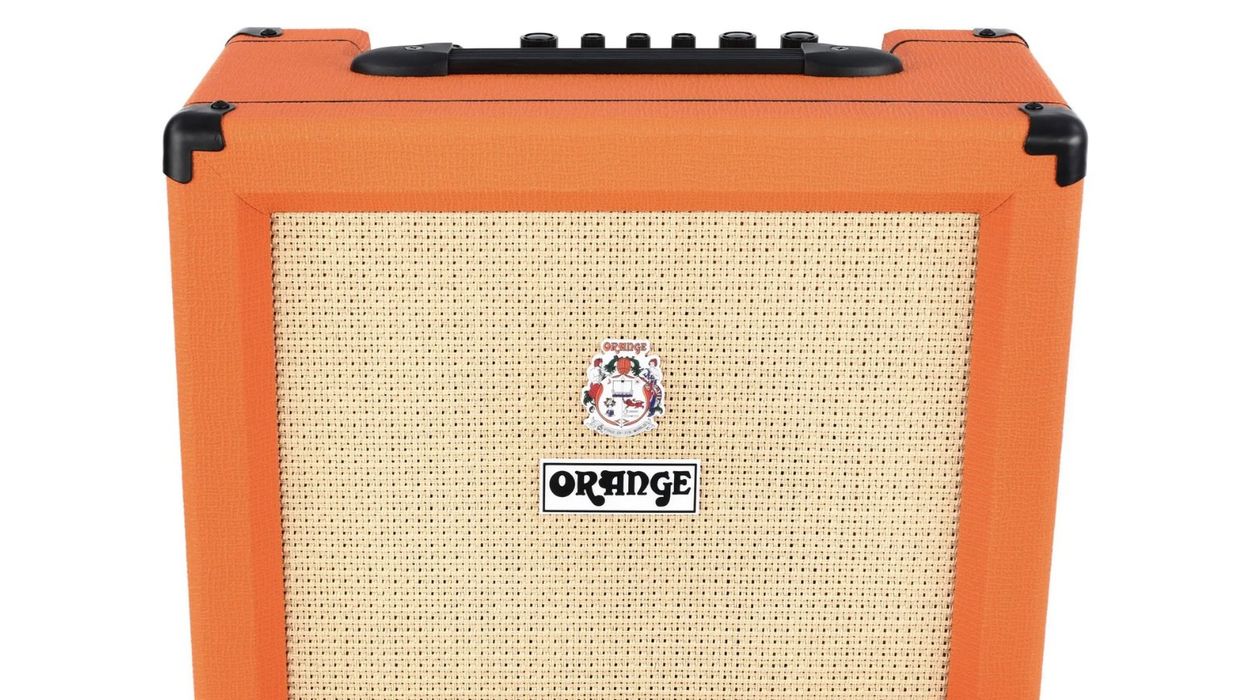| We also brought the pedals to Satriani tribute artist, Gary Lenn. Click here to read his thoughts. |
Just because I'm a Satch fan doesn’t mean I want to sound like him. Well maybe I do a little bit, but there’s already a Joe Satriani and I prefer to make up my own stuff. I’m a bad copycat when it comes to nailing signature guitar styles and tones. For me, testing these pedals was about ease of use, finding sounds I could use to make my own music and the joy of shameless guitar wanking. When I received the Vox Time Machine, Saturator and Big Bad Wah in the mail, I was filled with Christmas morning glee. I couldn’t wait to put on my bald skin cap, dark sunglasses and plug them into my Peavey JSX Joe Satriani signature head.
The Look
First off, these pedals have a hip-but-solid look to them. The vibrant red and green colors are eye-catching, and they sit handsomely on your pedalboard, taking up a bit more space than similar effects. I'm of the opinion that it’s important to have a good-looking pedalboard. How your pedalboard looks is a direct reflection of the guitarist within. A good looking, clean, well laid out pedal board says, “I’m a virile, confident stud who’s got it goin’ on!” There’s no doubt in my mind that Joe Satriani has put a lot of thought into these pedals to help you look as cool as possible.
The Time Machine is a dual-mode delay pedal, the Satchurator is a distortion pedal with a boost option and the Big Bad Wah is a dual-mode Wah. I tested these bad boys with various Strat-style guitars with both humbuckers and single coils, as well as with a very happening Fender Richie Kotzen signature Telecaster. For amps I used a vintage spec ’65 Fender Deluxe Reverb Reissue, a ’66 Fender Pro Reverb, a Marshall JCM800 and a Peavey JSX Joe Satriani signature head.
Time Machine Delay
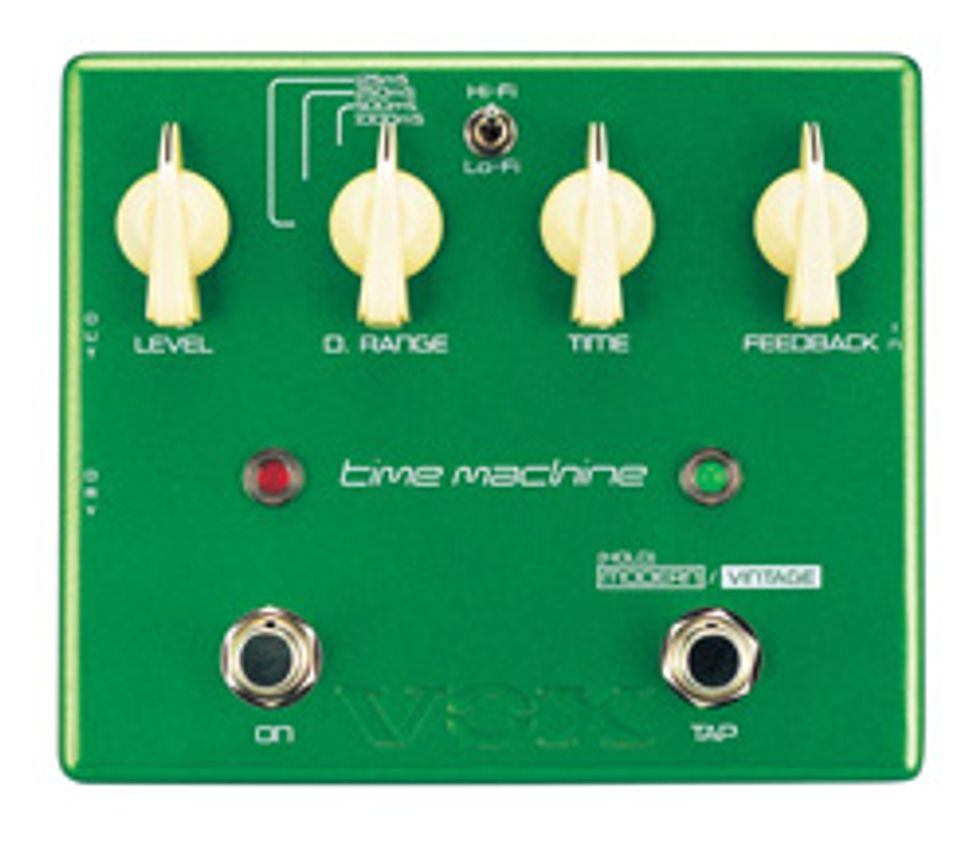 |
| Watch Joe talk about the Time Machine: Click here to see full-size video |
Although I didn’t find this pedal as transparent as some other digital delays I own, that wasn’t a bad thing. I could hear a little coloring but it was for the better. The Modern Delay setting sounded very smooth and far from sterile, while the Vintage setting had a subtle-but-warm old school vibe. I’ve never been one to get into wacky one-man-band delay settings, but I could dial in anything from long Brian May-style repeats to tight Brian Setzer-style rockabilly slap back.
The Hi-Fi/Lo-Fi switch is supposed to allow you to roll off the high frequencies so it sits better in the mix, but it was a little too faint sounding to my ears. It’s set to Satriani’s exact specifications so you know it’s a real guitar player’s delay pedal. It blends very well with your guitar signal and doesn’t sound like added junk in your chain. The Tap Delay was the easiest I’ve ever used. I was easily able to set the delay to do triplets, eighth notes, dotted eighth notes, or quarter notes depending on the range setting. I love a good warm arena rock slap back and this pedal truly delivers.
The Final Mojo
This is my favorite pedal of the three and the most versatile for a variety of different types of players and musical styles. It’s a great sounding pedal. There are cheaper pedals out there with more features, but not everyone needs the ability to play backwards guitar or looping capabilities. Few others can match the onstage functionality of the Time Machine, and most don't sound as warm as even the Modern Delay mode.
The Time Machine is easy on the eyes, easy to use and basically performs the duties of a great delay pedal with wide adjustable parameters. The Hi-Fi/Lo-Fi switch might be better suited for players with persnickety studio ears, but the quality of the overall sound through various rigs is impressive. The warmth, delay options and ability to adjust the effect volume to your needs, makes this a keeper.
Buy if...
you're a fan of warm delay.
Skip if...
you hate the idea of signature guitar effect.
Rating...
MSRP $300 - VOX - voxamps.com |
Satchurator
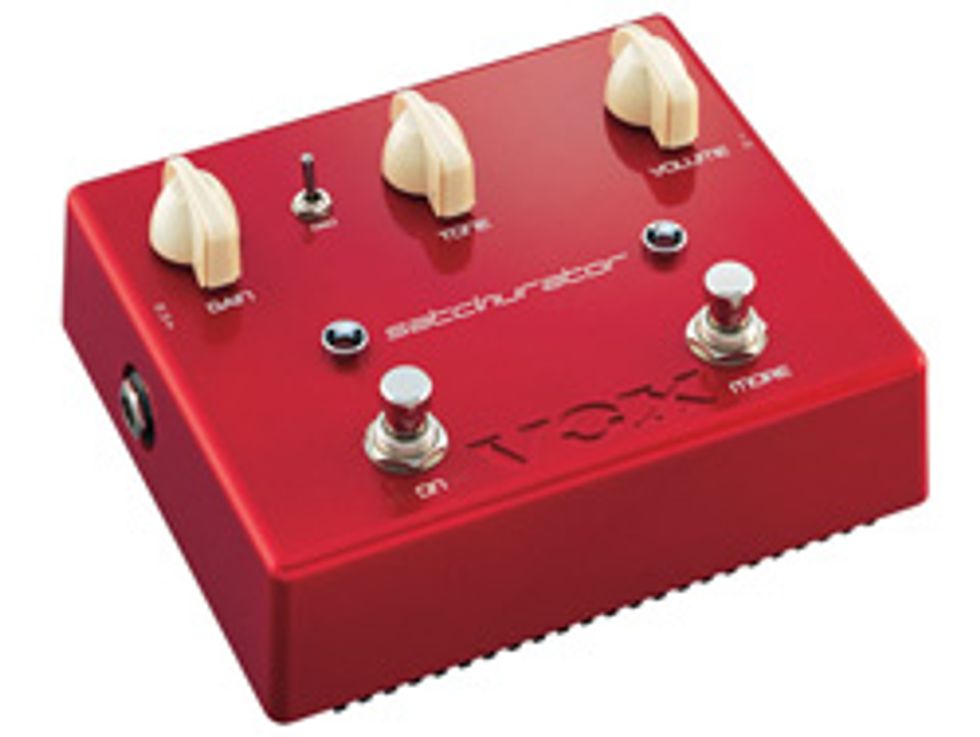 |
| Watch Joe talk about the Satchurator: Click here to see video full-size |
The first thing I thought when I plugged it in was, “It does the AC/DC thing.” It’s grittier than one might expect from a Joe Satriani pedal. With the gain and tone at twelve o’clock, I did not immediately fall in love, but I could see that this pedal had more going on than meets the ear. I got some interesting grindy tones, but it wasn’t until I found the sweet spot with the tone control that I found what I sought. That sweet spot was right around nine or ten o’clock, and anything below that was muddy. Everything above that got more and more grind. I have a preference for smooth, high-gain lead tones; I could imagine other players digging the scratchy, dirty rock rhythm vibe with the tone closer to twelve o’clock. It showed a lot of versatility in that ballpark.
Maxing out the gain is where the fun was for me. It had the kind of big rock lead tones I was expecting, but earthier. When I added the More switch to the maxed out lead tone, it only gave me a slight boost and a tad more midrange. It wasn’t that big of a difference—it basically had nowhere to go—but it was noticeable. The money setting is putting the gain at twelve o’clock and the tone around nine o’clock, giving you a warm-but-dirty blues-rock lead and rhythm tone. When you engage the More switch, you get the over-the-top singing lead voice as if you had the gain maxed out. Now you have somewhere to go. In this setting it’s like having two pedals in one, and I found it more versatile and enjoyable for application during an actual gig. The Pad switch was too subtle for me to get what the big deal was, but I get the idea based on the info in the instruction manual.
Strangely enough, the pedal sounded richer and more articulate using single coil pickups. It’s not true-bypass, but it cleaned up nicely—backing off with the guitar’s volume and achieving great harmonic overtones with the guitar’s volume full on. At times I was getting what I call the “Santana on Steroids” tone. The pedal is a great match for playing through a Peavey JSX on the clean channel, more so than a few of the dirtier amps I tried. The JSX has an awesomely transparent clean channel regardless of volume and the lack of dirt allows the pedal to really shine. The Satchurator is tougher and more blusey sounding than the gain channels on the JSX, so it’s not redundant—it’s a whole different sound. The JSX and Saturator definitely compliment each other, which comes as no surprise.
Running in front of a JSX, the Satchurator is pretty awesome with bulbous chordal articulation for days. Chords rang out forever and wouldn’t shut up. The lead tones were very organic, a tad hairy and never processed sounding. There was very little noise even with the More switch engaged. For someone playing through different amps, be aware that your tones will vary. Be prepared for some quasi Big Muff-style assaults. Playing through a cranked Marshall brought out the more gnarly aspects of the pedal because of the amp’s breakup. You can dial out some of that, but you’ll still be left with some rugged gristle. The exception to this is when I plugged the pedal into my cranked Fender Deluxe Reverb along with my Fender Richie Kotzen signature model Telecaster. It was the best sounding combination all night. It sounded smooth, luxurious and absolutely gorgeous.
The Final Mojo
The gain channels on a Peavey JSX sound more like Satriani than this pedal, but that’s ok. This pedal does other things. You can get morbidly obese lead tones with just enough compression to keep it together, or fuzzier sounds with more bite that might be the perfect thing to cut through a loud band mix. You don’t have to play ten-minute guitar instrumentals with it either. I dialed in some nice early Rolling Stones rhythm sounds with no trouble. The Tone knob reacts differently with different amps. While smaller amps got more upper grind with the tone knob past ten o’clock, it sounded incredible at twelve o’clock through a fully cranked JSX on the clean channel in a large room. Regardless of what amp you run it through, you’ll have no trouble finding the sweet spot with this pedal.
Buy if...
you dig Satch's sound and then some.
Skip if...
you want more tonal variety of the upper end of the EQ spectrum.
Rating...
MSRP $160 - VOX - voxamps.com |
Big Bad Wah
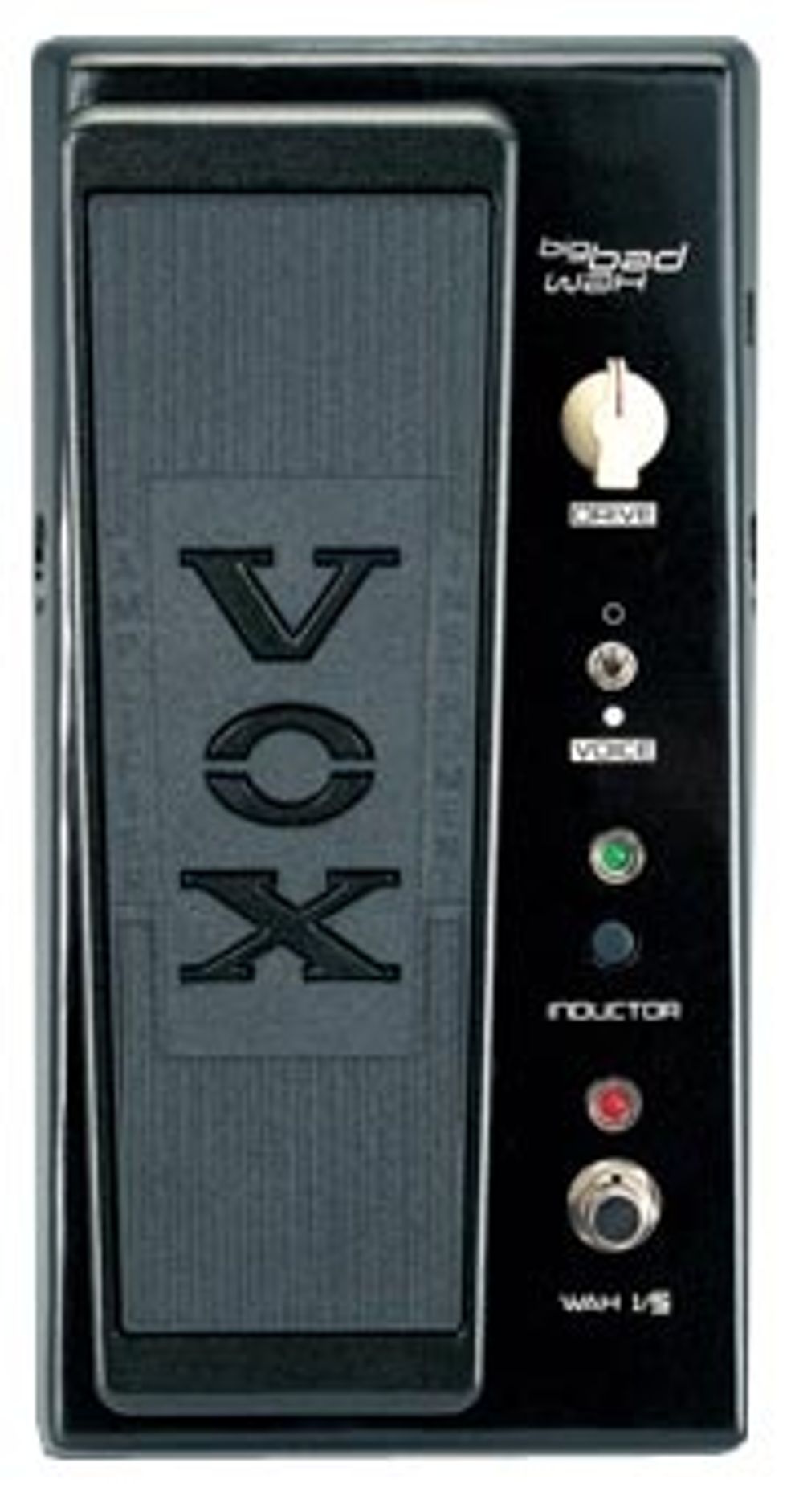 Yes, I have a wah addiction and I don’t care who knows it. From Michael Schenker to the “Theme from Shaft,” the wah is the coolest yet most over used pedal on the planet. I am guilty as charged, but Joe Satriani is an enabler. He offers some cool options to this beloved pedal and you’ll want to use this model a little too much.
Yes, I have a wah addiction and I don’t care who knows it. From Michael Schenker to the “Theme from Shaft,” the wah is the coolest yet most over used pedal on the planet. I am guilty as charged, but Joe Satriani is an enabler. He offers some cool options to this beloved pedal and you’ll want to use this model a little too much. It’s a dual mode wah where the footswitch at the bottom right side of the pedal takes you to the dark side of tonal world domination. Wah One is the classic British Vox sound. Wah Two gets you variations of Satriani’s signature wah sound and the ability to sculpt mayhem of your own. Its adjustable drive and two inductors let you construct the voices you hear in your head. When Wah Two is engaged you can utilize the Drive knob to go from boost to “growly.” With the drive all the way to the left, it takes you back to the Vox signature sound.
The Voice mini-toggle lets you choose between bright or warm and dark, while the Inductor switch allows you to move between a UK-style wah and the American voiced version.
| Watch Joe talk about the Big Bad Wah: Click here to see the video full-size. |
Wah One won’t get you that aged, mellow, comfy sound that Madison Square Bedroom gear snobs are after. It’s a harder, modern British wah sound. Its got great honk, sweep and natural smoothness. It’s clean, but might not be clean enough for wah-wah cork sniffers who like the sound of old pedals aged to perfection. At the top of the sweep it stops just short of being ice picky. It sounds great with lead tones, letting your distortion or overdrive shine unhampered. As stated, the lack of mellowness could turn off a few guitarists right up until they use it in an actual band context. Using real battlefield conditions are essential when trying out wahs. It’ll cut through any band mix without being annoying and offer a sweet upper mid vowel colorization without being harsh.
Wah Two is where it gets interesting. It’s a pedal tweaker's delight, but is simple enough that plug-in-and-go types won’t have a brain hemorrhage trying to figure it out. You can’t help but want to crank up the drive and burn some rubber. It’s less transparent than Wah One, but transparency is kinda not the point. Wah Two begs like a horny prostitute for that big, bad, boosted wah solo. It was born for this. It made sweet love to all my distortion pedals and compelled my Marshall JCM800 to sing like a bitch. I visited Michael Schenker Land and gave Kirk Hammet a run for his money. Thick, rich and chocolatey upper midrange tones emerged. I appreciate that I had the option of switching between a brighter or warmer sound with the Voice mini-toggle. The Drive knob dirties things up, but it never gets ridiculous. It’s very musical, has true-bypass circuitry and works well with the Inductor button for great tone shaping options. I like it. I like it a lot.
The Final Mojo
The Big Bad Wah sounded outstanding through every amp I played through. It lacks the classic mellow aged feel that a lot of pedal makers are pushing, but I can’t imagine Satriani was thinking mid-'70s Curtis Mayfield when he thought up this pedal. The Big Bad Wah allows you to get the stock Vox wah sound, their take on an American wah and plenty of tonal variety. Cranking this up with your favorite distortion pedal and manipulating the Drive knob will give you some bodacious in-your-face rock tones. It ain’t cheap, but you get what you pay for with this pedal and it offers a lot of splendiferous sounds and big rock supremacy.
Buy if...
you want a wah that has more than one sound.
Skip if...
the idea of tonal choices in a wah induces psychological trauma.
Rating...
MSRP $280 - VOX - voxamps.com |
Thoughts From a Pro
| I went one step beyond and enlisted the help of Joe Satriani tribute artist Gary Lenn. Gary is a Los Angeles-based guitarist who knows all of Satch’s tunes, tones and every little semi-quaver. His Joe Satriani tribute band, Surfing With An Alien, puts on one hell of a great show. If there’s anyone who knows Joe Satriani’s tonal palette inside and out, it’s this guy. We hooked up at Sound Studios in beautiful Van Nuys California and plugged all the pedals into his Peavey JSX half stack. Then we turned it up really loud. Here’s what he had to say: Time Machine: “It’s fricken' awesome! It’s soft but much fatter than the original Boss delay pedals Satch used to use, that I’m using now. He’s a genius the way he uses delay. This pedal is really nice. It makes all the clean stuff sound more beautiful and lush but it doesn’t override anything. The repeats fall gently away really nicely too. I like the vintage mode the best. It sounds warmer. It makes everything I do sound better. The functionality of this is truly awesome.” Saturator: “It’s really fat. I call it 'meat.' It’s really quiet too. It’s actually better than the Ultra channel on the JSX. It’s like putting chocolate pudding on a chocolate cake. Satch does 90% legato stuff and I have to be able to pull that off. The More button adds sustain while I’m playing those lines. I love this pedal. It makes me want to disregard the other two gain channels on the amp. I honestly think this pedal would make me a better player. It gives you so much more to work with.” Big Bad Wah: “It’s ten times better than what I’ve been using. It’s like night and day. It’s very pure and doesn’t add a lot of crap and noise. I like the sweep and it really contours and beefs things up. Wah Two adds a little crunch that sounds really cool, but it’s still clean and extremely versatile. I could use it by it self with a clean channel to add a little bit of dirt. The only downside to this is that I have to go to a store and buy it. I’m absolutely blown away.” |




